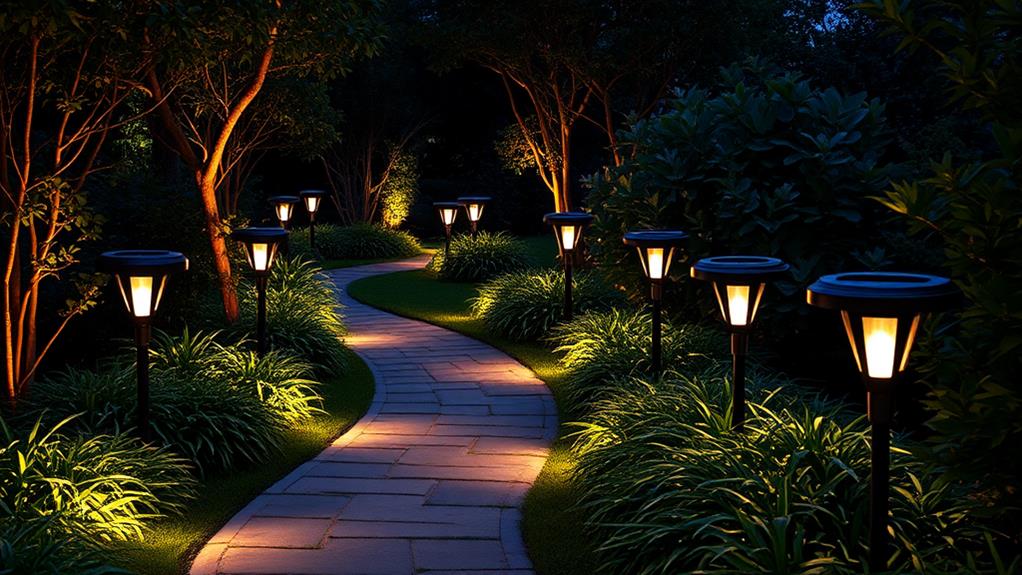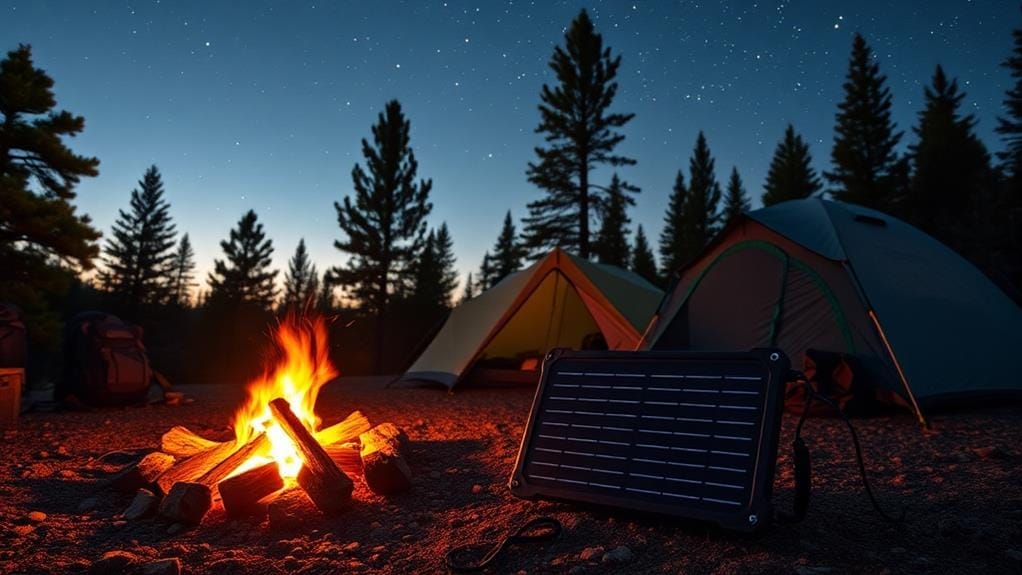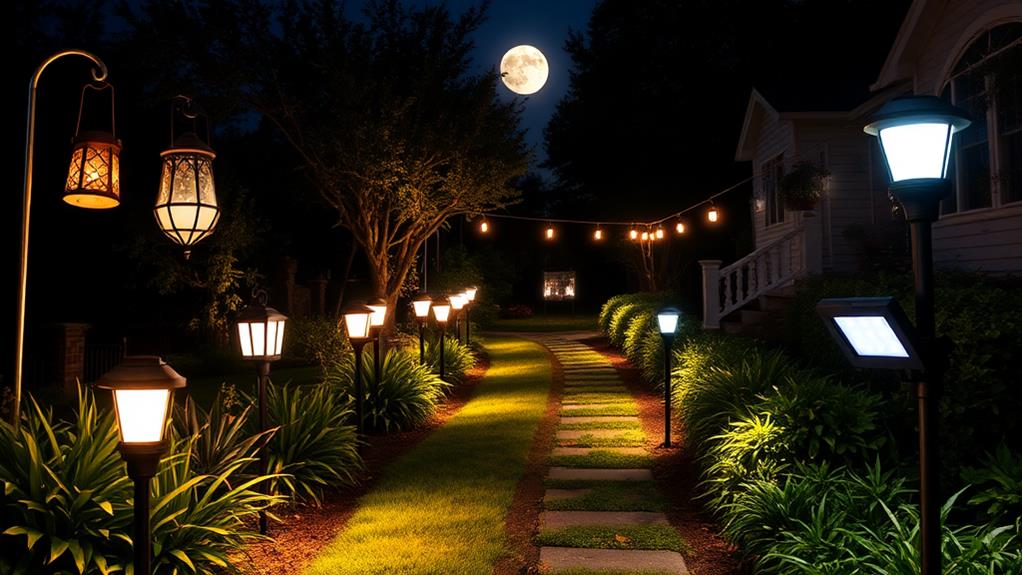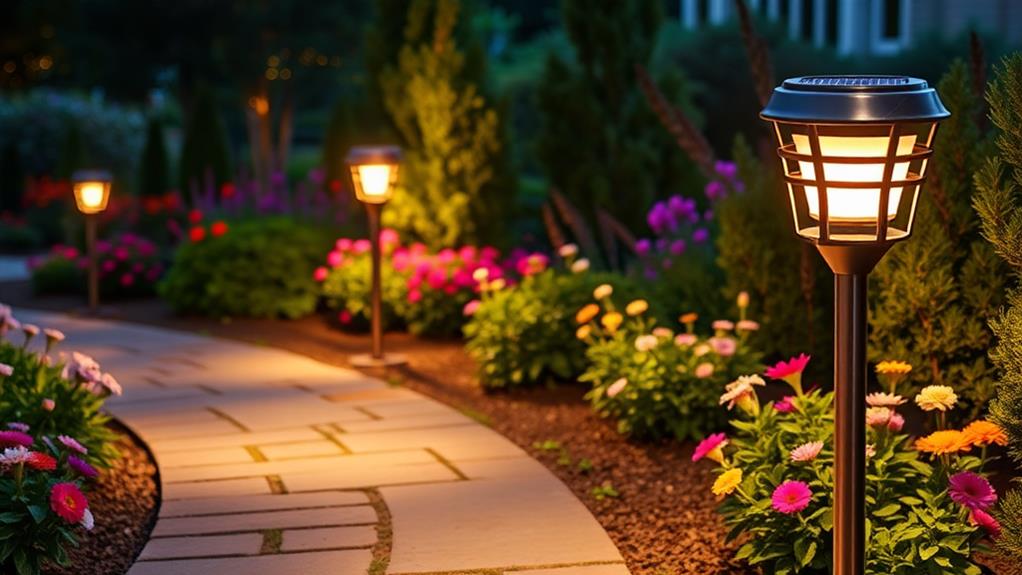In 2026, the top camping solar panels offer a blend of efficiency, durability, and portability. You’ll find models ranging from 100W to 160W, with conversion rates up to 23.5%. Key features include IP67/IP68 waterproofing, ETFE lamination, and foldable designs weighing 8-10 lbs. Most panels incorporate USB-A, USB-C, and MC4 outputs for versatile charging. Look for adjustable kickstands and smart IC chips to optimize performance. The DOKIO 160W kit stands out with its higher wattage, while the EF ECOFLOW 110W boasts superior build quality. When selecting, consider power output, weight, weather resistance, and device compatibility. Exploring these options will reveal how modern solar technology enhances your outdoor power needs.
Key Takeaways
- High-efficiency panels (23%+) with 100W-160W outputs offer optimal power for camping needs.
- Lightweight, foldable designs (9-10 lbs) with compact dimensions enhance portability for outdoor use.
- Durability features like IP67/IP68 ratings and ETFE lamination ensure weather resistance and longevity.
- Multiple output options (USB-A, USB-C, DC) and smart charging technology provide versatile device compatibility.
- Adjustable kickstands and quick setup features maximize sunlight exposure and ease of use in varied conditions.


![[Upgraded] BigBlue 3 USB Ports 28W Solar Charger(5V/4.8A Max), Portable SunPower Solar Panel for Camping, IPX4 Waterproof, Compatible with iPhone 11/XS/XS Max/XR/X/8/7, iPad, Samsung Galaxy LG etc.](https://m.media-amazon.com/images/I/81Y+nxzTVGL._SS520_.jpg)
![[Upgraded] FlexSolar 60W Portable Solar Panels Chargers QC3.0 USB-A USB-C DC5521 8mm Output Foldable IP65 Waterproof Power Emergency Camping for Small Power Station Generator Tablets Battery Packs](https://m.media-amazon.com/images/I/71G3sBCJvjL._SS520_.jpg)



100W Portable Foldable Solar Panel for Power Stations
- 【Made For Solar Generator】Includes 3 DC adapters and 118 inches 5-in-1 MC4 cable, cable long enough for extra charging distance application make...
- 【IP68 Waterproof & Ultra-Durable】TWELSEAVAN 110W solar panels are made of advanced ETFE one-piece laminated technology, IP68 waterproof,...
- 【Effortlessly Capture the Sunlight】Equipped with a solar angle guide and two quick-adjust stands, this system ensures you can easily adjust the...
Last update on 2026-01-05 / Affiliate links / Images from Amazon Product Advertising API
Campers seeking a high-efficiency, portable solar solution will find the 100W Portable Foldable Solar Panel an excellent choice. This versatile panel, compatible with various power stations including Jackery, EF ECOFLOW, and Bluetti, boasts a conversion efficiency of up to 23.5% using A+ grade 9BB monocrystalline solar cells. The IP68 waterproof rating and ETFE lamination guarantee durability in outdoor conditions, while the folded dimensions of 24*21.8 inches and weight of 10.1 lbs make it highly portable. You’ll appreciate the 118-inch 4-in-1 MC4 cable for flexible setup and the two adjustable kickstands for maximum sunlight absorption. Users report impressive performance, with outputs exceeding the advertised wattage, achieving up to 116 watts on compatible devices. Despite minor issues with wiring and stand design, the overall customer feedback is positive, highlighting the panel’s ease of use and effective charging capabilities.
Best For: Outdoor enthusiasts and campers seeking a high-efficiency, portable solar charging solution compatible with various power stations.
Pros:
- High conversion efficiency of up to 23.5% with A+ grade 9BB monocrystalline solar cells
- Compact and lightweight design with easy setup and adjustable kickstands
- Durable construction with IP68 waterproof rating and ETFE lamination
Cons:
- Some users reported issues with wiring, potentially affecting compatibility with certain power stations
- Included cable length may be insufficient for some setups
- Kickstand design could be improved for better stability
100W Foldable Solar Charger with USB Output for Camping and RV
- 【Versatile Output and Wide Compatibility】100 watt solar panel comes with a controller which is equipped with 4 versatile interfaces to meet all...
- 【A+ Monocrystalline Solar Cells for 23.5% Conversion Efficiency】 Our 100W solar panel portable is crafted with top-tier A+ monocrystalline silicon...
- 【Robust and IP67 Waterproof】The portable solar panel for camping features an ETFE coating that provides waterproof, dustproof, and long-lasting...
Last update on 2026-01-05 / Affiliate links / Images from Amazon Product Advertising API
Outdoor enthusiasts seeking a powerful and versatile solar charging solution will find the 100W Foldable Solar Charger an excellent choice. This high-efficiency panel boasts a 23.5% conversion rate and an IP67 waterproof rating, ensuring peak performance in various conditions. The charger’s controller features four versatile interfaces, including USB-A and USB-C outputs, making it compatible with 95% of portable power stations.
Constructed with A+ monocrystalline silicon solar cells and protected by an ETFE coating, this durable panel weighs 9.48 lbs and folds to 24.13 x 21.06 x 1.77 inches. Smart IC chips in the controller provide maximum charging efficiency, while multiple protection features safeguard your devices. The package includes a 10ft 4-in-1 solar cable and a 10-in-1 DC connector, enhancing its versatility. With a 12-month warranty and 24/7 customer support, this solar charger offers reliability and peace of mind for your outdoor power needs.
Best For: Outdoor enthusiasts, campers, and RV owners who need a reliable, high-capacity solar charging solution for their portable power stations and devices.
Pros:
- High efficiency with 23.5% conversion rate and versatile output options
- Durable construction with IP67 waterproof rating and ETFE coating
- Smart charging technology with multiple protection features
Cons:
- Relatively heavy at 9.48 lbs, which may be cumbersome for backpackers
- Limited USB ports (only two USB-A and one USB-C)
- May be overkill for users with smaller power needs or limited space
DOKIO 160W Portable Folding Solar Panel Kit
- 【COMPACT & TRAVEL-READY】 Folds down to 19.3x20.9x1.1in and just 7.3lb—light enough to pack, carry, and set up solo. Perfect for RVs, vans,...
- 【LONG CABLE, COOLER & SAFER】 9.8ft (3m) cable lets you park the panel in full sun while your controller or power station stays shaded—better...
- 【SEPARATE CONTROLLER, SAFER CHARGING】 Includes a standalone PWM controller for 12V batteries with full protections (reverse polarity, overcharge,...
Last update on 2026-01-05 / Affiliate links / Images from Amazon Product Advertising API
When you’re looking for a versatile and powerful solar solution for your camping adventures, the DOKIO 160W Portable Folding Solar Panel Kit stands out. This lightweight, foldable panel weighs just 9 lbs (7.28 lbs for the panel itself) and measures 20.9 x 19.3 x 1.1 inches, making it highly portable. With a robust 160W power output and 18V voltage, it’s compatible with various 12V batteries and power stations, including popular brands like Jackery, Goal Zero, and Ecoflow. The kit includes a 10A controller and multiple connector types (SAE/XT60/DC/Alligator clip), ensuring versatility for different setups. You’ll appreciate the 9.85 ft cable length from panel to controller, with an optional 19.7 ft extension available. The high-efficiency monocrystalline solar cells and built-in protection against overcharging, overload, and short-circuits make this an excellent choice for outdoor enthusiasts seeking reliable, eco-friendly power.
Best For: Outdoor enthusiasts, campers, and RV owners seeking a portable, high-capacity solar power solution for off-grid adventures and emergency backup power.
Pros:
- Lightweight and foldable design for easy transportation and storage
- High power output of 160W with versatile connectivity options
- Compatible with various 12V batteries and popular power stations
Cons:
- Relatively high price point compared to lower wattage options
- Limited warranty period of only 1 year
- May require additional accessories for optimal use in some setups
100W Portable Foldable Solar Panel for Camping and Power Stations
- 🔋𝐇𝐢𝐠𝐡 𝐂𝐨𝐧𝐯𝐞𝐫𝐬𝐢𝐨𝐧 𝐄𝐟𝐟𝐢𝐜𝐢𝐞𝐧𝐜𝐲 - Harness the power of the sun with our 100W...
- 🔄𝐖𝐢𝐝𝐞 𝐂𝐨𝐦𝐩𝐚𝐭𝐢𝐛𝐢𝐥𝐢𝐭𝐲 𝐟𝐨𝐫 𝐏𝐨𝐰𝐞𝐫 𝐍𝐞𝐞𝐝𝐬 - Engineered with...
- 🌧️𝐃𝐮𝐫𝐚𝐛𝐥𝐞 & 𝐖𝐞𝐚𝐭𝐡𝐞𝐫-𝐑𝐞𝐬𝐢𝐬𝐭𝐚𝐧𝐭 𝐃𝐞𝐬𝐢𝐠𝐧 - Built for the...
Last update on 2026-01-05 / Affiliate links / Images from Amazon Product Advertising API
For adventure seekers who demand versatility and power on the go, the 100W Portable Foldable Solar Panel stands out as a top choice. This monocrystalline panel boasts a maximum conversion efficiency of 23.7%, capable of fully charging a 500Wh power station in just 7 hours under ideal sunlight conditions. With its IP65 waterproof rating and ETFE lamination, it’s built to withstand various weather conditions, ensuring durability and longevity.
You’ll appreciate the panel’s compatibility with popular solar generators, thanks to its array of connectors, including 8mm, 5.5*2.5mm, 3.5*1.35mm, 5.5mm*2.1mm, and Anderson DC adapters. The dual USB ports (USB-C 5V/3A and USB-A 5V/3A) allow for direct charging of small devices. Weighing 8.16 pounds and featuring adjustable kickstands, this portable panel offers a balance of power and convenience for your off-grid adventures.
Best For: Outdoor enthusiasts, campers, and off-grid adventurers seeking a powerful, portable, and versatile solar charging solution for their devices and power stations.
Pros:
- High conversion efficiency (up to 23.7%) for faster charging
- Wide compatibility with various solar generators and devices
- Durable construction with IP65 waterproof rating and ETFE lamination
Cons:
- Relatively heavy at 8.16 pounds, which may be cumbersome for backpackers
- Actual power output may vary depending on weather conditions
- May require additional accessories for optimal use with some power stations
EF ECOFLOW 110W Portable Solar Panel for Camping and RVs
- Highly Efficient. With an industry-leading 23% conversion rate, EcoFlow solar panels can charge your solar generator faster and more efficiently than...
- Powerfully Portable. Foldable solar panels that are designed to go wherever life takes you. Ideal as an RV solar panel, camping solar panel and...
- Weather, Water and Dust Proof. With an IP68 waterproof rating, these portable solar panels are made for the outdoors and can withstand the elements.
Last update on 2026-01-05 / Affiliate links / Images from Amazon Product Advertising API
Campers and RV enthusiasts seeking a high-efficiency portable solar panel should consider the EF ECOFLOW 110W. This panel boasts a 23% conversion rate and an IP68 waterproof and dustproof design, making it ideal for outdoor use. While its performance varies, users have reported real-world outputs of 65-90% of rated power, with some achieving up to 136W under favorable conditions. The foldable design and kickstand case enhance portability and allow for angle adjustments to maximize solar exposure. However, it is essential to highlight that the EF ECOFLOW comes at a higher price point compared to competitors like Renogy and Dokio. Despite mixed reviews on performance, many users appreciate the panel’s ease of setup and quality materials, with positive experiences reported during events like Hurricane Idalia.
Best For: Campers and RV owners who prioritize high efficiency and portability in a solar panel, and are willing to pay a premium for quality and durability.
Pros:
- High conversion rate of 23% and IP68 waterproof design for reliable outdoor performance
- Foldable design with adjustable kickstand for easy transport and optimal solar exposure
- Positive customer service experiences with quick resolutions and replacements
Cons:
- Higher price point compared to competitors offering similar or better performance
- Inconsistent real-world performance, with some users reporting lower efficiency than expected
- Concerns about long-term durability and potential heat-related issues during extended use
100W Portable Solar Panel for Power Station and Camping
- 【23.5% High-Efffciency A+ Monocrystalline Cells】Constructed with premium Grade A+ silicon cells, this 100W solar panel outperforms conventional...
- 【True 5-in-1 Universal Connectivity】 Unlike standard 4-in-1 cables, our upgraded solar cable features 5 distinct connectors to fit 99% of power...
- 【IP67 Waterproof ETFE Coating】 Designed for the unpredictability of outdoor life. The advanced ETFE lamination offers superior durability, heat...
Last update on 2026-01-05 / Affiliate links / Images from Amazon Product Advertising API
The 100W Portable Solar Panel by ZOUPW is ideal for tech-savvy campers who need reliable power on the go. This monocrystalline panel boasts a 23.5% conversion efficiency, generating up to 100W at 20.16V and 4.96A. Its IP67 rating and ETFE coating guarantee durability in outdoor conditions, while the smart charging technology provides multiple protections. The panel’s versatile output options include USB-A, USB-C, and a 10ft 4-in-1 solar cable for compatibility with various devices and power stations. Weighing 9.48 lbs and featuring a foldable design with magnetic handle, it’s highly portable. The dual kickstands allow for quick setup and angle adjustment to maximize sunlight absorption. With a 12-month warranty and 24/7 customer support, ZOUPW offers peace of mind for your outdoor power needs.
Best For: Outdoor enthusiasts, campers, and tech-savvy travelers who need a reliable and portable solar power solution for charging devices and power stations in remote locations.
Pros:
- High efficiency (23.5%) monocrystalline solar panel with 100W output
- Versatile charging options with multiple USB ports and compatibility with various power stations
- Durable and weather-resistant design with IP67 rating and ETFE coating
Cons:
- Relatively heavy at 9.48 lbs, which may be cumbersome for ultralight backpackers
- Cannot store electricity, requiring a separate power station or battery for energy storage
- May not be suitable for all power stations due to varying input power limits
Factors to Consider When Choosing Solar Panels for Camping

When selecting solar panels for your camping adventures, you’ll need to weigh several vital factors to guarantee you’re getting the most suitable equipment for your needs. These factors include the panel’s power output capacity, which determines how much energy it can generate; its portability and weight, affecting ease of transport; durability and weather resistance, essential for withstanding outdoor conditions; compatibility with your devices; and efficiency in varied lighting conditions. By carefully considering these aspects, you’ll be better equipped to choose solar panels that will reliably power your camping gear and enhance your outdoor experience.
Power Output Capacity
Power output capacity stands as an vital factor when choosing solar panels for camping. Typically measured in watts, common options for portable camping panels range from 100W to 160W, providing sufficient power to charge portable power stations and devices effectively. When selecting a panel, you’ll want to take into account your specific power needs and charging time requirements. Higher wattage panels, such as those rated at 100W or above, offer faster charging capabilities for larger power stations, often achieving full charge in approximately 7-8 hours under ideal sunlight conditions.
It’s important to evaluate the panel’s conversion efficiency, with 23% or higher regarded as efficient for maximizing power generation during limited sun exposure. Real-world performance can vary, but high-quality panels often achieve up to 90% of their rated power output in ideal conditions, particularly in direct sunlight. When reviewing power output capacity, don’t overlook compatibility with your devices. Efficient models typically offer multiple output options, including USB and DC outputs, guaranteeing versatility in charging various camping equipment. Examine the output voltage and amperage specifications to make sure they align with your devices’ requirements for ideal charging performance.
Portability and Weight
Seasoned campers know that portability and weight are essential factors when selecting solar panels for outdoor adventures. When choosing your camping solar setup, prioritize panels that weigh around 9-10 lbs, as these strike a favorable balance between power output and ease of transport. Look for foldable designs with compact dimensions, typically measuring 24 inches when collapsed, enabling effortless storage in backpacks or vehicles.
To enhance portability, consider panels equipped with magnetic handles, which facilitate quick and convenient transport without the need for additional carrying cases. Adjustable kickstands are vital for stable ground placement and ideal sunlight absorption, ensuring maximum efficiency during use. Additionally, prioritize panels with quick setup features, allowing you to deploy your solar array in seconds and maximize sunlight exposure throughout your camping trip.
When evaluating solar panel options, pay close attention to the manufacturer’s specifications regarding weight, folded dimensions, and setup time. These factors will greatly impact your overall camping experience, determining how easily you can transport, set up, and relocate your solar power system as needed throughout your outdoor adventures.
Durability and Weather Resistance
Designed to withstand the elements, durable and weather-resistant solar panels are vital for successful camping trips. When selecting panels, prioritize a waterproof rating of IP67 or higher to guarantee protection against rain and splashes. This rating indicates the panel’s ability to resist water ingress, safeguarding its internal components from moisture damage.
Look for panels constructed with ETFE lamination, a material that greatly enhances resistance to UV rays, dust, and mechanical wear. This durable construction extends the panel’s lifespan, assuring long-term reliability in harsh outdoor conditions. Additionally, opt for models that have undergone rigorous testing for temperature extremes, as high-quality panels maintain performance in both hot and cold weather.
For maximum portability without compromising durability, choose lightweight panels weighing under 10 lbs. These panels should still provide robust performance despite their reduced mass. Confirm your selected panel includes protective features such as overvoltage and short-circuit protection, which safeguard against electrical hazards during adverse weather conditions. These safety mechanisms are essential for maintaining the panel’s integrity and your personal safety while camping in unpredictable environments.
Compatibility With Devices
Selecting the right solar panel for your camping adventure extends beyond durability considerations to device compatibility. When choosing a solar panel, you’ll need to verify it’s compatible with the devices you plan to charge, such as portable power stations or small electronics. Many modern panels offer multiple output options, including USB-A, USB-C, and DC outputs, providing versatility for various charging needs. It’s essential to check your devices’ maximum input voltage and wattage specifications to confirm that the solar panel can deliver sufficient power without exceeding limits.
Look for panels equipped with connectors that match your devices, such as MC4 connectors, to facilitate seamless connections. Additionally, consider the panel’s efficiency rating; higher efficiency (23% or more) translates to more power generation in less sunlight, a significant factor for charging devices during limited daylight hours while camping. When evaluating options, pay close attention to the panel’s technical specifications, including voltage range, amperage, and supported charging protocols. This guarantees peak performance and prevents potential compatibility issues that could leave you without power in the wilderness.
Efficiency in Varied Conditions
When camping, your solar panels must perform efficiently in a variety of conditions. To guarantee peak performance, consider panels with conversion efficiencies up to 23.5%, allowing for effective power generation even in suboptimal sunlight. Real-world performance often varies, with panels typically delivering 65-90% of their rated output depending on environmental factors like shading and sunlight angle. Look for durability ratings such as IP67 or IP68, indicating resistance to dust and water ingress, which helps maintain efficiency during outdoor use in diverse weather conditions.
Adjustable kickstands are vital for maximizing sunlight exposure throughout the day, enabling you to reposition panels as needed. Smart charging technology further enhances efficiency by regulating output and protecting against overvoltage, overcurrent, and short circuits. This guarantees consistent performance and safeguards your devices. When selecting solar panels for camping, prioritize those with high conversion efficiencies, robust durability ratings, adjustable positioning features, and smart charging capabilities. These factors will contribute to reliable power generation across varied environmental conditions, guaranteeing your devices remain charged during your outdoor adventures. By considering these technical specifications, you’ll be well-equipped to choose solar panels that offer peak efficiency in the diverse conditions encountered while camping.
Setup Ease and Flexibility
Nearly all camping enthusiasts prioritize setup ease and flexibility when choosing solar panels for their outdoor adventures. To meet these demands, manufacturers have developed foldable designs that enhance portability and facilitate rapid deployment in various outdoor settings. These panels, typically measuring around 24 inches when folded, offer compact storage and transport solutions. Adjustable kickstands are an essential feature, allowing users to optimize the panel’s angle for maximum sunlight absorption and efficiency across different terrains and times of day.
When selecting a camping solar panel, prioritize models incorporating lightweight materials, such as advanced monocrystalline solar cells. These components not only improve handling but also boost overall performance. Quick setup times are vital; opt for panels that can be deployed in seconds, minimizing disruption to your outdoor activities. The ideal camping solar panel should strike a balance between portability, efficiency, and ease of use. By focusing on these key factors—foldable design, compact size, adjustable positioning, lightweight construction, and rapid deployment—you’ll guarantee that your chosen solar panel meets the rigorous demands of outdoor environments while providing reliable power generation for your camping needs.
Frequently Asked Questions
How Long Do Portable Solar Panels Typically Last Before Needing Replacement?
You’ll typically find that portable solar panels can last between 10 to 25 years before requiring replacement, depending on various factors such as build quality, usage patterns, and environmental conditions. High-quality monocrystalline panels often boast longer lifespans, while polycrystalline variants may degrade slightly faster. Regular maintenance, including cleaning and proper storage, can greatly extend their operational life. It’s important to highlight that a panel’s efficiency may decrease by 0.5-1% annually, even if it’s still functional.
Can Camping Solar Panels Be Used to Power Medical Devices?
Just as Prometheus brought fire to mankind, you can harness the sun’s power for essential medical needs. You’ll find that many camping solar panels can indeed power medical devices, provided they meet voltage and wattage requirements. It’s important to calculate your device’s power consumption, typically measured in watts, and make certain your solar panel’s output matches or exceeds this. You’ll also need a compatible battery or power station to store energy for nighttime or cloudy conditions.
Are There Any Specific Maintenance Requirements for Portable Solar Panels?
You’ll need to perform regular maintenance on your portable solar panels to guarantee peak performance. Clean the panels’ surface with a soft cloth and mild detergent to remove dirt, dust, and debris that can reduce efficiency. Inspect connections and wiring for corrosion or damage, tightening loose connections as needed. Check the charge controller’s settings and functionality periodically. Store panels in a dry, cool place when not in use, and protect them from physical impacts. Periodically test the panels’ output to verify they’re operating at full capacity.
How Do Extreme Temperatures Affect the Performance of Camping Solar Panels?
Like a delicate flower wilting in harsh conditions, solar panels’ performance can be greatly impacted by extreme temperatures. You’ll notice that high temperatures reduce voltage output, while low temperatures decrease current. Most panels operate ideally between 15°C and 35°C (59°F to 95°F). Beyond these ranges, efficiency can drop by 0.5% per degree Celsius above 25°C (77°F). In frigid conditions, panels may produce up to 25% less power, necessitating proper insulation and positioning to mitigate these effects.
Can Portable Solar Panels Be Connected in Series for Increased Power Output?
Yes, you can connect portable solar panels in series to increase voltage output. When you wire panels in series, you’ll add their voltages while maintaining the same amperage. This configuration is useful for charging higher-voltage battery banks or when using longer cable runs to minimize power loss. However, you’ll need to verify your charge controller can handle the increased voltage. Remember, series connections are more susceptible to shading issues, as one shaded panel can reduce output for the entire string.















